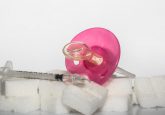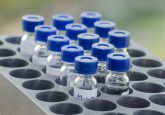Very smart phone doubles as a biosensor
A custom-made handheld cradle allows smartphone to efficiently and accurately carry out label-free biodetection.
Researchers at the University of Illinois (Urbana-Champaign, IL, USA), in collaboration with LensVector Inc. (Maynard, MA, USA), a company specializing in optical technology, have developed a smartphone that may be used as a detection instrument for a label-free photonic crystal biosensor.
Utilizing its integrated camera as a spectrometer, the smartphone is capable of detecting toxins, proteins, bacteria, viruses and other molecules. A custom-designed cradle holds the smartphone in fixed alignment with the test sample, while externally provided broadband light, incident upon an entrance pinhole, is subsequently collimated and linearly polarized before passing through the biosensor, which resonantly reflects only a narrow band of wavelengths. A custom software app then converts the camera images into the photonic crystal transmission spectrum in the visible wavelength, computing the photonic crystal resonant wavelength with an accuracy 9 pm.
According to a media release from the University of Illinois, the specially tailored cradle, which comprises optical components worth approximately US$200, possesses the ability to perform to the same level of accuracy as a large $50,000 spectrometer in the laboratory, making the device not only portable, but also affordable.
The new technology capitalizes on society’s reliance upon smartphones for obtaining information and for communication. Brian Cunningham, who led the research project, commented that by exploiting the powerful computing and imaging capabilities of phones, “A lot of medical conditions might be monitored very inexpensively and non-invasively using phones as a mobile platform.” Cunningham envisions the use of phones for the detection of “molecular entities, like pathogens, disease biomarkers or DNA, things that are currently only done in big diagnostic labs with lots of expense and large volumes of blood.”
The team has so far demonstrated sensing of an immune-system protein, but point out that the smartphone’s microscope slide could be primed for any type of biological molecule or cell type. The group recently received a grant from the National Science Foundation (Arlington, VA, USA) to expand the range of biological experiments that can be performed by the phone. The team are also collaborating with Juan Andrade, Professor of Food Science and Human Nutrition at the University of Illinois, to develop an efficient biosensor test for iron deficiency and vitamin A deficiency in children and expectant mothersThe group’s future plans also entail improvements to the manufacturing process for the cradle, which is currently built for iPhones, and the development of a cradle for Android phones.
Sources: Gallegos D, Long KD, Yu H et al. Label-free biodetection using a smartphone. Lab Chip 13, 2124–2132 (2013); Cradle turns smartphone into handheld biosensor.




